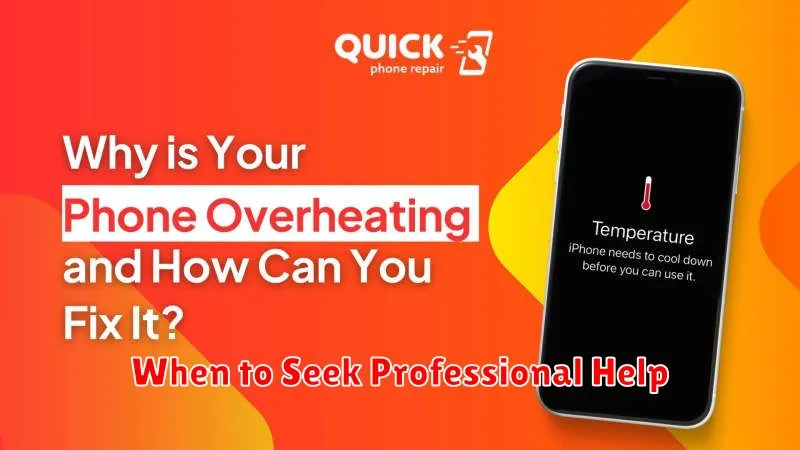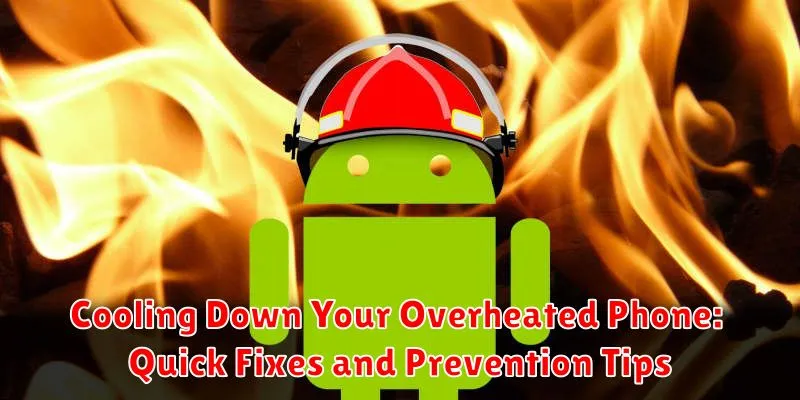Has your phone ever felt like a hot potato in your hand? An overheated phone can be more than just uncomfortable; it can significantly impact performance, battery life, and even cause permanent damage. This article will explore effective methods for cooling down your overheated phone quickly, offering quick fixes for when your device is running hot. We will also delve into prevention tips to help you avoid overheating in the future and maintain optimal phone health. Understanding the causes of phone overheating and implementing these quick fixes and preventative measures will help ensure your device runs smoothly and efficiently for years to come.
From demanding games and resource-intensive apps to prolonged charging and direct sunlight exposure, several factors contribute to phone overheating. If you’re experiencing a hot phone, it’s crucial to address the issue promptly. This guide will equip you with the knowledge and tools to cool down your overheated phone safely and prevent future occurrences. Learn practical quick fixes like closing demanding apps, optimizing settings, and using appropriate chargers. We’ll also discuss prevention tips to maintain a healthy operating temperature, prolonging the life of your device and ensuring a consistently smooth user experience.
Identifying the Signs of an Overheating Phone
Recognizing the signs of an overheating phone is crucial for preventing potential damage. The most obvious sign is a noticeable increase in the phone’s temperature. The device may feel uncomfortably warm or even hot to the touch.
Performance issues can also indicate overheating. These can manifest as sluggishness, apps taking longer to load, or the phone becoming unresponsive. You may also notice a decrease in battery life, with the battery draining much faster than usual.
In some cases, the phone may display a warning message about its temperature. This is a clear indication that the device is overheating and requires immediate attention.
Finally, unexpected shutdowns can also be a symptom of overheating. If your phone repeatedly shuts down without any other apparent reason, overheating could be the culprit.
Immediate Actions to Cool Down Your Phone
If your phone becomes uncomfortably hot, take swift action to prevent potential damage. First, remove the phone’s case as this can trap heat. Next, turn the phone off completely. This allows the internal components to rest and cool down without generating further heat.
Avoid charging the phone while it’s overheated as this will exacerbate the issue. Find a cool, shaded area away from direct sunlight and allow the device to cool naturally. Do not put it in the refrigerator or freezer. Rapid temperature changes can cause condensation, potentially damaging the internal circuitry.
Close any power-intensive applications that might be running in the background, such as games or streaming services. These can contribute significantly to heat generation. If possible, activate airplane mode to temporarily disable all wireless communication, further reducing the load on the processor.
Common Causes of Phone Overheating
Several factors can contribute to a phone overheating. Understanding these causes can help you take preventative measures. One of the most common culprits is extensive gaming. Graphically demanding games push the phone’s processor and graphics unit, generating significant heat.
Streaming high-definition video for extended periods also puts a strain on the phone’s hardware, leading to increased temperatures. Similarly, using the phone while charging, especially with resource-intensive apps running, generates extra heat from both the phone’s operation and the charging process.
Environmental factors can also play a role. Direct sunlight and high ambient temperatures can cause the phone to absorb more heat than it can dissipate. Malfunctioning apps or software bugs can sometimes force the processor to work harder than necessary, leading to overheating. Finally, a worn-out battery may struggle to manage power efficiently, contributing to excessive heat generation.
Preventing Your Phone from Overheating

Proactive measures can significantly reduce the risk of your phone overheating. Avoid leaving your phone in direct sunlight, especially inside a hot car. Even on cloudy days, the sun’s rays can generate substantial heat within a vehicle.
When charging your phone, choose a well-ventilated area. Avoid covering your device with blankets or pillows, as this traps heat. Also, using the phone while charging generates extra heat, so try to minimize usage during charging periods.
Case selection matters. Certain cases, particularly thick or poorly designed ones, can insulate the phone, preventing proper heat dissipation. Opt for a case designed for good ventilation or remove the case entirely when engaging in activities known to generate heat, such as gaming or streaming videos.
Be mindful of the ambient temperature. On hot days, limit strenuous activities on your phone, especially outdoors. If you’re using GPS navigation in a hot car, consider an alternative mounting solution that promotes airflow around the device.
Regularly closing unused apps can minimize background processes and reduce strain on your phone’s resources, which in turn, helps prevent overheating. Keep your phone’s software updated, as updates often include performance optimizations and bug fixes that can improve thermal management.
Long-Term Solutions for Overheating Issues
If you frequently experience overheating, consider these long-term solutions to address the root cause.
Optimizing Software and Apps
Regularly update your phone’s operating system and apps. Updates often include performance enhancements and bug fixes that can improve thermal management. Uninstall unused apps as they may still run background processes, contributing to heat generation.
Battery Health
Over time, batteries degrade and can generate more heat. If your phone is more than two years old, consider having the battery professionally checked and potentially replaced. Avoid using third-party chargers which may not adhere to proper safety standards and can stress the battery.
Usage Habits
Be mindful of how you use your phone, especially in hot environments. Avoid gaming or streaming video for extended periods while outdoors in direct sunlight. Give your phone a break to cool down if it begins to feel warm.
Consider Professional Repair
If overheating persists despite these measures, there might be an underlying hardware issue. Consult a qualified technician for diagnosis and repair. Internal components, such as a failing processor, can contribute to excessive heat generation.
Software and Hardware Considerations
Both software and hardware aspects of your phone can contribute to overheating. Software, such as demanding apps, background processes, and operating system bugs, can place a heavy load on the processor, generating excess heat.
Keeping your operating system and apps updated can often address software-related overheating. Updates frequently include performance optimizations and bug fixes that reduce strain on the processor. Consider uninstalling infrequently used apps, especially those known for high resource consumption.
On the hardware side, components like the battery, processor, and charging circuitry can overheat due to age, defects, or simply being overworked. Dust accumulation within the phone can also impede heat dissipation. If you suspect a hardware problem, avoid attempting repairs yourself. Instead, consult a qualified technician for diagnosis and repair. Damaged or aging batteries, in particular, require professional attention.
When to Seek Professional Help

While many overheating issues can be resolved with simple troubleshooting steps, some instances require professional intervention. If you’ve tried the basic cooling and prevention methods and your phone continues to overheat, it’s time to contact a qualified technician.
Persistent Overheating: If your phone overheats frequently, even with minimal usage, it indicates a more serious underlying problem. This could be a hardware malfunction, such as a failing battery or a problem with the internal cooling system.
Physical Damage: If your phone has experienced physical damage, like being dropped or exposed to liquids, and subsequently begins overheating, seek professional repair immediately. Internal components could be damaged, posing a safety risk.
Battery Swelling or Leakage: A swollen or leaking battery is a serious safety hazard. Do not attempt to fix this yourself. Contact your phone’s manufacturer or a qualified repair center for assistance.
Warranty Coverage: If your phone is still under warranty, contacting the manufacturer or authorized service center is the recommended course of action. They can diagnose the problem and offer repair or replacement options covered under your warranty.

